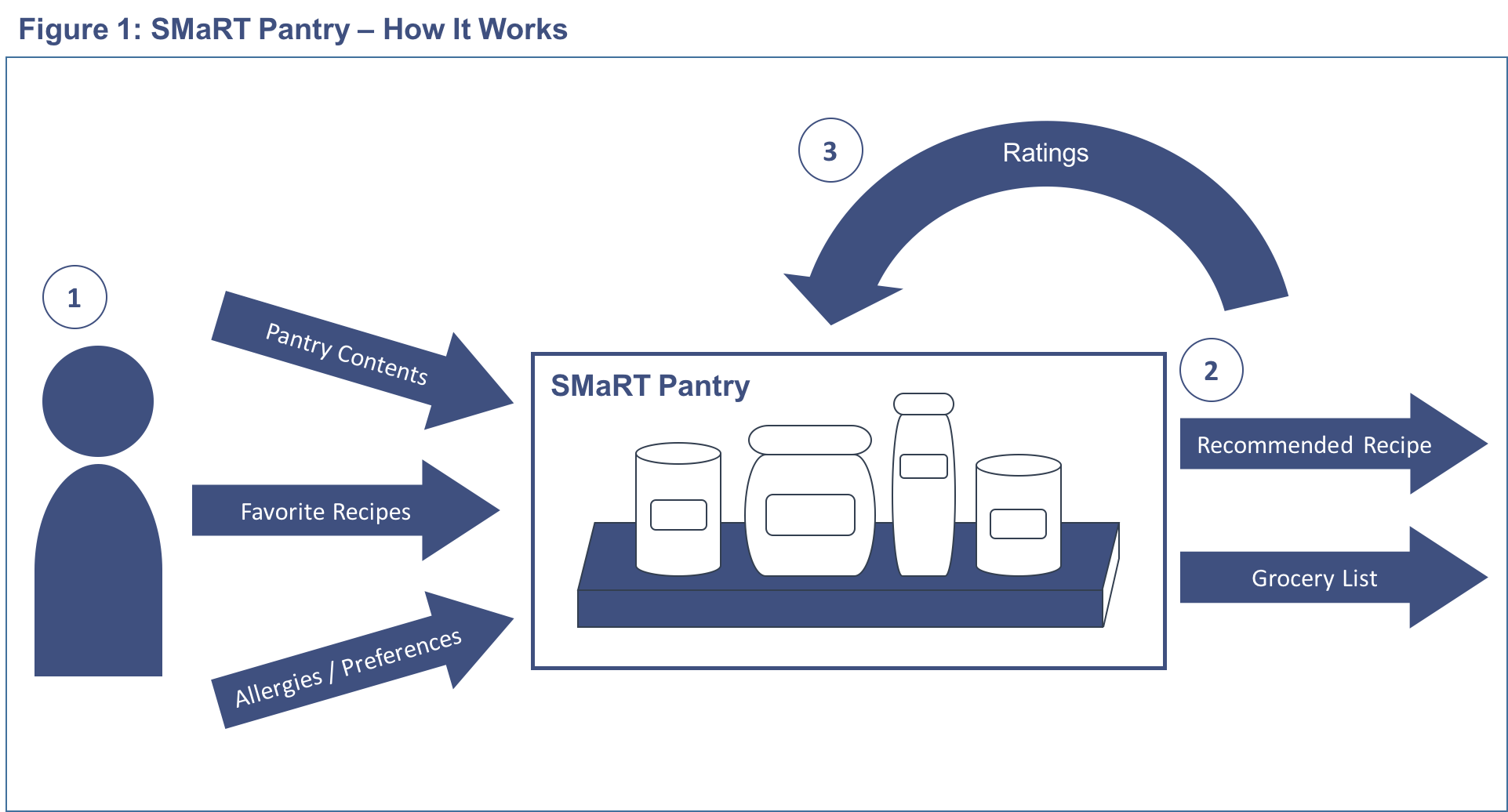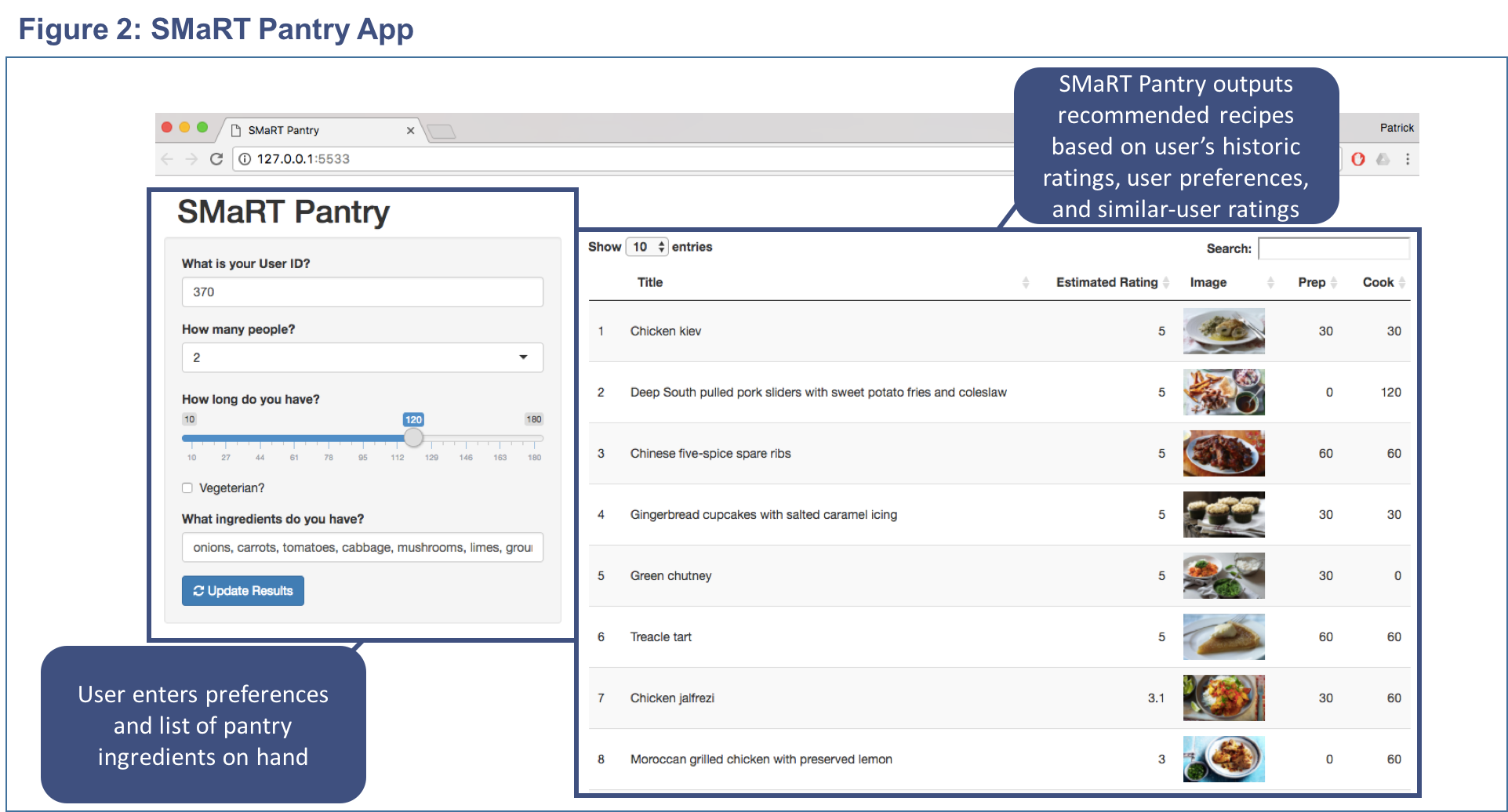SMaRT Pantry Makes It Easier to Cook at Home
More and more individuals are looking for solutions to make healthy, home cooked meals easier and cheaper. This growing market—as evidenced by companies like Blue Apron, a recent startup expected to have more than $1 billion in revenue this year [i]—targets those people who shy away from the inconvenience of cooking at home. When asked why they don’t cook, people’s answers range from not having the right ingredients to not being able to cook to not having the time to look for something quick and easy. SMaRT Pantry addresses each of these issues by providing users with recommended recipes that fit their cooking level while using ingredients already on hand.
Machine Learning Techniques Identify Recipes that Fit You
The Simple Meals and Recipes Tonight (SMaRT) Pantry uses machine-learning techniques to provide consumers with access to recipes that meet their flavor, cooking level, and time preferences while strategically choosing ingredients they already have in their refrigerator or pantry. By taking user preferences, data from similar users, and pantry contents, SMaRT Pantry generates customized dinner solutions – it’s like having a personal chef hand-pick every night’s dinner menu.
How it Works
Step 1: Pantry contents (as provided by store receipts or manually entered), favorite recipes, food allergies and dislikes, total cook-time preferences, health and budget desires, and preferred difficulty level are uploaded into the SMaRT Pantry app.
Step 2: SMaRT Pantry uses your historic data (ratings, similar-user preferences, recipe characteristics) and, with state-of-the-art machine learning technology, returns a personalized set of suggested recipes. Depending on your settings, this list may include recipes using only what’s currently found in your pantry, or it may generate a grocery list that allows you to pick up a few key items to execute the perfect recipe.
Step 3: Simply rate your meal to improve future recommendations. With additional use SMaRT Pantry gets better at personalizing recipes for you: providing new ideas and increased meal variety.
The Business of SMaRT Pantry
Initial Development
To prove our concept, we built a beta version of our app. First, we scraped over 10,000 recipes from various online data sources and compiled them into a centralized database. We then simulated user review data to act as a test case for our system—going forward we hope to replace this with actual recipe ratings. Next we built a machine learning algorithm that uses both singular value decomposition and item-based collaborative filtering to predict what a user will rate a given recipe based on their historic review pattern. The goal of these methods is to balance characteristics of recipes (e.g. recipes that are well reviewed in general) with user-specific preferences (e.g. finding similar consumers and using their ratings) to generate a predicted recipe rating. To better test this algorithm, we would need to gather real review data, either by launching our app or partnering with a recipe review platform like allrecipes.com.
Figure 2 shows our beta version of the app, which takes recipes from our database and matches them to users based on a user’s historic ratings. It then combines those predicted ratings with specific meal preferences and outputs a list of potential recipes for tonight.
Phase 1 (Present – 1 Year)
In Phase 1 we will grow a user base to cook and rate SMaRT Pantry’s recommended recipes. Users will benefit from time savings as they will no longer need to scour websites trying to decide on a meal, and with more use they will see that SMaRT Pantry is better able to predict which meals they will enjoy. When SMaRT Pantry reaches 50,000 reviews, the machine learning algorithm will begin to incorporate other user data into recommendations.
Phase 2 (1 Year – 2 Years)
During Phase 2, we will launch additional, paid features. Users will be able to subscribe to the service and begin tracking pantry inventory. Pantry inventory will be managed by having users scan in store receipts, through manual entry of information, and by the record a SMaRT Pantry recipes made. Besides recommending recipes, SMaRT Pantry will be able to use pantry data to recommend grocery lists based on 1) the frequency of typically-purchased items and 2) recipes that would be recommended with the addition of a few supplemental items. Finally, we would also begin to seek advertising revenue from free users.
Phase 3: Additional Features and Partnerships (2 Years +)
Grocery Delivery: Through a partnership with companies like Instacart, a grocery delivery service, SMaRT Pantry can make getting groceries even easier. Users only need to quickly review SMaRT Pantry’s recommended grocery list and through the click of a button have those items delivered within the hour. We anticipate a partner would be willing to pay us a small percentage of all orders placed through SMaRT Pantry.
Push Notifications: Push notifications will provide users with information on what products have been sitting in the pantry for a while and likely need to be used up before reaching their expiration dates. These will also be incorporated into recommended recipes if users note as a preference.
Integration with Other Technology: SMaRT Pantry could even be expanded to incorporate other augmented perception technology. Smart fridges, RFID tags, or other sensors could automatically identify pantry contents, or internet of things appliances could assist in recipe execution, perhaps by preheating the oven or starting a slow cooker in the morning.
Business Model and Funding Ask
The biggest hurdle SMaRT Pantry faces in its initial development is the gathering of user and recipe data. As such, we will begin exploring partnerships with online recipe providers to build a collection of recipes. More importantly, though, in order to be able to provide significant value to users, we estimate that our machine learning algorithms would need at least 50,000 recipe reviews. We estimate that the average user would leave 5 reviews and are assuming a user acquisition cost of about $5 [ii], meaning we require $50,000 for marketing to gather the initial 10,000 users. Beyond that hurdle, we would need about $40,000 for further app development and database hosting.
Once we have our initial set of data and users, we would focus on various avenues of revenue generation: advertising, paid subscriptions, and partnerships (e.g. Instacart). Because there are almost no physical costs to SMaRT Pantry, revenue generated through these methods would go straight to the bottom line, allowing SMaRT Pantry to fund its own continued development. The market for easier, simpler home-cooked meals is huge (larger than $1.5 billion annually [iii]), and SMaRT Pantry can capture a piece of that market at extremely low costs.
Technology vs. Human: SMaRT Pantry Has Us Beat
To demonstrate the effectiveness of SMaRT Pantry to a broader audience (between Phases 2 and 3), we propose a cooking challenge in which the target consumer provides information on her favorite recipes, allergies, and preferences to a professional personal chef. This chef, using a typical pantry, picks a recipe and prepares a meal for her. SMaRT Pantry takes the same information as the chef and, using its database of other users and user preferences, selects a recipe. A second professional chef will prepare this meal. The outcome? Our target customer tastes both meals and sees that SMaRT pantry is better able to predict what she likes. In other words, SMaRT Pantry is better than a personal chef picking your menu every night! The bonus, of course, is that she can use SMaRT Pantry herself and pick a recipe in a fraction of the time that it would usually take.
We could pilot this demonstration either directly for potential partners (showing them the value of this product) or to random potential customers. We could then use those results in advertising, showing testimonials where new users rave about how much the SMaRT Pantry understands their preferences. Our marketing could then be based around the idea of “having a personal chef pick your menu every night.” This gets to the core technology of the system—the data-based approach to choosing a meal that fits every individual’s needs and wants.
Sources
[i] https://www.recode.net/2016/10/2/13135112/blue-apron-revenue-run-rate-billion-ipo
[ii] https://fiksu.com/resources/mobile-cost-indexes/
[iii] https://www.eater.com/2016/5/20/11691446/meal-delivery-blue-apron-plated-hello-fresh-marley-spoon







